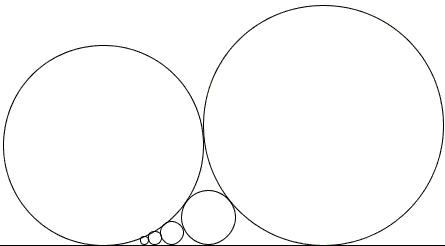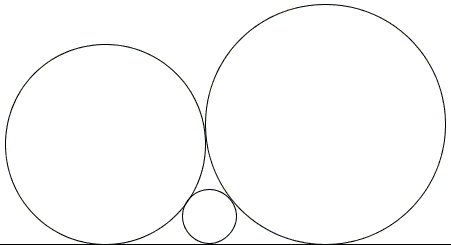A Sushi Morsel
Twice in his books Ross Honsberger discussed the following problem:

The first solution in [Gems] is rather a brute force use of coordinate geometry. The second solution [Morsels], which Honsberger attributes to C. Stanley Ogilvy, is based on the observation that, if L is seen as the circle of infinite radius, the problem is reduced to the study of the chain of circles in arbelos or as a particular case of Steiner's chains. The problem is then elegantly reduced to the sequence of circles in a strip of paper by inversion in the circle centered at the point of tangency of C0 with L and of radius 2R0.
The earlier discussion comes with no reference; in the later one, Honsberger points to the book Mathematical Games and Pastimes by A. P. Domoryad (Pergamon Press, 1964, problem 19, p. 242).
In a recent article published in The Mathematical Gazette, M. Hajja gives an elementary solution to the problem that makes use of a known result concerning three mutually tangent circles standing on a straight line:

Assuming the radii of the three circles in the diagram are successively R0, R1, R2 we have
| (1) | 1/√R2 = 1/√R1 - 1/√R0. |
By induction, then
| (2) | 1/√Rn = 1/√R1 - (n - 1)/√R0. |
Denoting 1/√Rn = un, we convert (2) to a simple linear relation
| (3) | un = u1 - (n-1)u0, n > 1. |
Since, for all n, un > 0, (3) shows that the process may continue as long as
| (4) | n < 1 + u1 / u0, i.e, n ≤ u1 / u0 |
For R0 = 106mm and R1 = 1 mm, u1 / u0 = 103. Which means that it is impossible to construct circle C1001 and C1000 is the last one, thus solving the problem. (The solution from [Morsels] shows also that R1000 = R0, giving another reason why the process can't continue beyond
The point of this note is to observe that the problem and the simple solution above both have a long history. Relation (1) is the subject of an 18th century sangaku. Relation (2) appeared in its generality in a 1789 sangaku and in several modifications during the 19th century. This may be one of those cases where Wasan - the traditional Japanese geometry - beat the West to a punch.
References
- M. Hajja, On a Morsel of Ross Honsberger, The Math. Gazette, v. 93, n. 527, July 2009, pp. 309-312
- R. Honsberger, Mathematical Gems, MAA, 1973, pp. 52-53, 153-155
- R. Honsberger, Mathematical Morsels, MAA, 1978, pp. 218-219
Sangaku
- Sangaku: Reflections on the Phenomenon
- Critique of My View and a Response
- 1 + 27 = 12 + 16 Sangaku
- 3-4-5 Triangle by a Kid
- 7 = 2 + 5 Sangaku
- A 49th Degree Challenge
- A Geometric Mean Sangaku
- A Hard but Important Sangaku
- A Restored Sangaku Problem
- A Sangaku: Two Unrelated Circles
- A Sangaku by a Teen
- A Sangaku Follow-Up on an Archimedes' Lemma
- A Sangaku with an Egyptian Attachment
- A Sangaku with Many Circles and Some
- A Sushi Morsel
- An Old Japanese Theorem
- Archimedes Twins in the Edo Period
- Arithmetic Mean Sangaku
- Bottema Shatters Japan's Seclusion
- Chain of Circles on a Chord
- Circles and Semicircles in Rectangle
- Circles in a Circular Segment
- Circles Lined on the Legs of a Right Triangle
- Equal Incircles Theorem
- Equilateral Triangle, Straight Line and Tangent Circles
- Equilateral Triangles and Incircles in a Square
- Five Incircles in a Square
- Four Hinged Squares
- Four Incircles in Equilateral Triangle
- Gion Shrine Problem
- Harmonic Mean Sangaku
- Heron's Problem
- In the Wasan Spirit
- Incenters in Cyclic Quadrilateral
- Japanese Art and Mathematics
- Malfatti's Problem
- Maximal Properties of the Pythagorean Relation
- Neuberg Sangaku
- Out of Pentagon Sangaku
- Peacock Tail Sangaku
- Pentagon Proportions Sangaku
- Proportions in Square
- Pythagoras and Vecten Break Japan's Isolation
- Radius of a Circle by Paper Folding
- Review of Sacred Mathematics
- Sangaku à la V. Thebault
- Sangaku and The Egyptian Triangle
- Sangaku in a Square
- Sangaku Iterations, Is it Wasan?
- Sangaku with 8 Circles
- Sangaku with Angle between a Tangent and a Chord
- Sangaku with Quadratic Optimization
- Sangaku with Three Mixtilinear Circles
- Sangaku with Versines
- Sangakus with a Mixtilinear Circle
- Sequences of Touching Circles
- Square and Circle in a Gothic Cupola
- Steiner's Sangaku
- Tangent Circles and an Isosceles Triangle
- The Squinting Eyes Theorem
- Three Incircles In a Right Triangle
- Three Squares and Two Ellipses
- Three Tangent Circles Sangaku
- Triangles, Squares and Areas from Temple Geometry
- Two Arbelos, Two Chains
- Two Circles in an Angle
- Two Sangaku with Equal Incircles
- Another Sangaku in Square
- Sangaku via Peru
- FJG Capitan's Sangaku
|Contact| |Front page| |Contents| |Geometry|
Copyright © 1996-2018 Alexander Bogomolny
73608603
